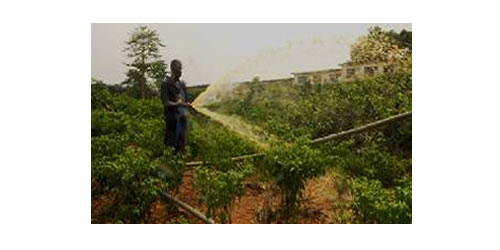Productivity of Rice Farms to increase dramatically with new hybrid varieties

The productivity of rice farmers in Africa would soon increase dramatically with the development of new indigenous hybrid varieties that are capable of yielding up to 7 tonnes per hectare.
The average productivity on rice farms currently is about 4 tonnes per hectare. The new varieties were developed by the “Hybrid Rice: Breeding by Design Project.”
The objective of the project is to improve food security and rural livelihoods among African small-scale rice producers through the development of hybrid rice with significant yield advantage.
Two varieties are currently undergoing trials in Kenya and would soon get to other parts of Africa whilst the performance of 127 other rice hybrids are being evaluated by the project.
Africa spends billions of US Dollars importing rice annually. In 2014 for instance, Africa imported 13 million tonnes costing over $5billion. Ghana, for example, spends about $400 million importing rice annually.
“Hybrid rice seeds currently being planted in Africa are either imported from Asia or America. Egypt is the only country in Africa that has developed its own rice hybrids. With this breakthrough, Africa will realise its own high yielding hybrid seeds, consequently boosting production and moving closer to self-sufficiency in rice production,” a statement from the African Agricultural Technology Foundation which coordinates the Hybrid Rice project said.
Africa will soon have its own rice hybrids thanks to a public-private partnership project, the Hybrid Rice: Breeding by Design Project, that has developed the first ever indigenous hybrid rice in Sub-Saharan Africa (SSA).
The varieties which have been developed using the 2-line rice hybrid technology have the potential to produce 7 tonnes per hectare.
Kenya will be among the first countries to benefit from this pioneering breakthrough in rice breeding in SSA as early as next year considering that two hybrids are already undergoing national performance trials.
Farmers in Tanzania are likely to get access to the hybrids in 2018.
The project is further evaluating the performance of 127 rice hybrids for advancement to national performance trials, according to Dr Kayode Sanni, the Project Manager.
Hybrid rice seeds currently being planted in Africa are either imported from Asia or America. Egypt is the only country in Africa that has developed its own rice hybrids. With
this breakthrough, Africa will realise its own high yielding hybrid seeds, consequently boosting production and moving closer to self-sufficiency in rice production.
This is indeed good news to farmers, seed companies and rice consumers in SSA. While global production of rice has risen steadily from 132 million tonnes in 1960 to 491.5 million tonnes in 2015, Africa has not contributed much to the increase, producing only 3 per cent, with Asia accounting for 90 percent of the global production.
Rice demand on the continent exceeds production and Africa have been forced to rely heavily on importing large quantities of rice to meet demand at a huge cost. In 2014, for instance, Africa imported 13 million tonnes costing over $5billion.
With demand increasing at between 6-12 percent over the last 10 years, Dr Sanni warns the cost is likely to increase unless there is a drastic increase in local production.
SSA produces 14.8 million of milled rice per year but consumes nearly double that amount at 26.4 million tonnes of milled rice per year. Except for a few countries that have attained self-sufficiency in rice production, as many as 21 of the 39 rice-producing countries in Africa import between 50 and 99 percent of their rice requirements.
Kenya is one of the countries that have had to heavily rely on imports. The country’s annual demand for milled rice is 550,000 tonnes. With an annual production of 102,000 tonnes, the imported 420,000 tonnes in 2015 were not enough to cater for demand, leaving the country with a deficit of 15,000 tonnes.
Uganda on her part imported 53.8 percent of her rice requirements of 223,000 tonnes. Uganda produces 143,000 tonnes of milled rice per year.
With an annual production of 1,700,000 tonnes and an annual consumption of 1,770,000 tonnes, Tanzania is the only country in East Africa that appears to be heading towards self-sufficiency in rice with annual imports accounting for only 5.6 percent.
“Hybrid rice technology revolutionised rice production in Asia dramatically increasing productivity from an average of 1.89 tonnes per hectare in 1949 to 6.71 in 2012, and it will do the same for Africa,’ states Dr Denis Kyetere, Executive Director African Agricultural Technology Foundation (AATF), that coordinates the Hybrid Rice project.
‘Now that we have also acquired the 2-line hybrid rice technology, Africa should be self-sufficient in rice production and even compete globally for exports, and not imports,” added Dr Kyetere.
Africa’s inability to reach self-sufficiency in rice is the result of a combination of several factors in the rice industry. The continent suffers low rice productivity averaging 2.2 t/ha against the global average of 3.4 t/ha.
This is largely caused by lack of high-performing varieties, poor seed systems making it difficult for farmers to access certified and high quality seeds and vagaries of weather brought about by climate change. Farmers are further discouraged from investing in rice due to high production costs that make their products more costly and hence less competitive in the market.
Unlike maize, there is insufficient private sector investment in rice production in Africa, an issue Dr Sanni attributes to a lack of hybrid rice technologies.
“Historically, hybrid crop model has been used to leverage private sector involvement in agriculture. Besides offering significant yield gains to farmers, hybrid technologies also offer viable agri-businesses to seed companies through sustained seed sales. Investment in rice production by seed companies can only be encouraged by using hybrid rice technology. The huge African rice deficits are indeed a great business opportunity for seed companies,” states Sanni
For hybrid rice technology to take root in Africa, both the public and the private sectors will need to appreciate the big business opportunities and increase their investment in rice production. The increased investments could be channelled to addressing the challenges facing adoption of hybrid rice technology such as unavailability of parental lines, lack of capacity on hybrid rice technology, and inadequate awareness on hybrid rice benefits to farmers.
Source: myjoyonline.com





